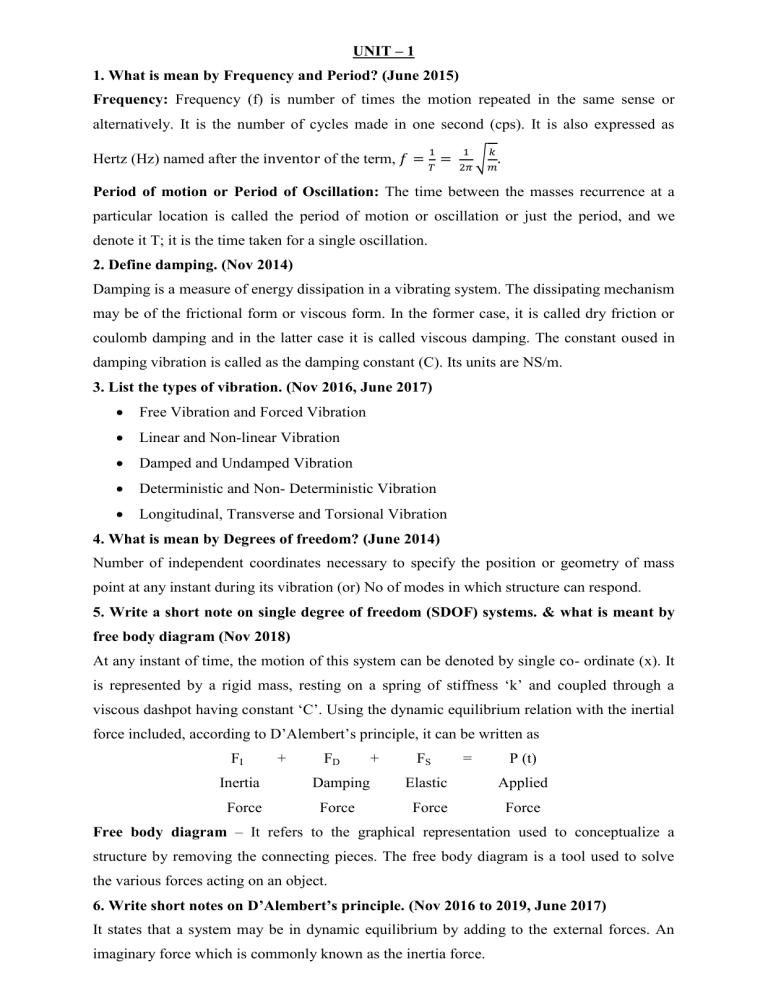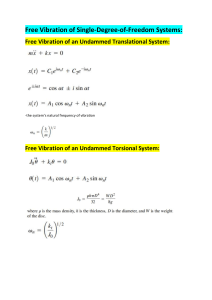
UNIT – 1 1. What is mean by Frequency and Period? (June 2015) Frequency: Frequency (f) is number of times the motion repeated in the same sense or alternatively. It is the number of cycles made in one second (cps). It is also expressed as 1 Hertz (Hz) named after the inventor of the term, 𝑓 = 𝑇 = 1 𝑘 √ . 2𝜋 𝑚 Period of motion or Period of Oscillation: The time between the masses recurrence at a particular location is called the period of motion or oscillation or just the period, and we denote it T; it is the time taken for a single oscillation. 2. Define damping. (Nov 2014) Damping is a measure of energy dissipation in a vibrating system. The dissipating mechanism may be of the frictional form or viscous form. In the former case, it is called dry friction or coulomb damping and in the latter case it is called viscous damping. The constant oused in damping vibration is called as the damping constant (C). Its units are NS/m. 3. List the types of vibration. (Nov 2016, June 2017) Free Vibration and Forced Vibration Linear and Non-linear Vibration Damped and Undamped Vibration Deterministic and Non- Deterministic Vibration Longitudinal, Transverse and Torsional Vibration 4. What is mean by Degrees of freedom? (June 2014) Number of independent coordinates necessary to specify the position or geometry of mass point at any instant during its vibration (or) No of modes in which structure can respond. 5. Write a short note on single degree of freedom (SDOF) systems. & what is meant by free body diagram (Nov 2018) At any instant of time, the motion of this system can be denoted by single co- ordinate (x). It is represented by a rigid mass, resting on a spring of stiffness ‘k’ and coupled through a viscous dashpot having constant ‘C’. Using the dynamic equilibrium relation with the inertial force included, according to D’Alembert’s principle, it can be written as FI Inertia Force + FD + FS = P (t) Damping Elastic Applied Force Force Force Free body diagram – It refers to the graphical representation used to conceptualize a structure by removing the connecting pieces. The free body diagram is a tool used to solve the various forces acting on an object. 6. Write short notes on D’Alembert’s principle. (Nov 2016 to 2019, June 2017) It states that a system may be in dynamic equilibrium by adding to the external forces. An imaginary force which is commonly known as the inertia force. According to Newtons law F = ma The system considered to be in equilibrium when the action of real force “R” and the imaginary force “ma”. This “ma” is known as inertia force. 7. Define logarithmic decrement method / What is meant by logarithmic decrement (June 2014, Nov 2017, 2019) Logarithmic decrement is defined as the natural logarithmic value of the ratio of two adjacent peak values of displacement in free vibration. It is a dimensionless parameter. The logarithmic decrement can be found from: 𝑥 𝛿 = 𝑙𝑜𝑔𝑛 (𝑥1 ) = 2 2𝜋𝜉 √1−𝜉 2 For small damping, the above equation can be approximated as: 𝑥1 𝛿 = 𝑙𝑜𝑔𝑛 ( ) = 2𝜋𝜉 𝑥2 Where, x1 = Initial displacement x2 = Second displacement ξ = Damping ratio 8. Define critical damping. (June 2016) Critical damping is defined as the minimum amount of damping for which the system will not vibrate when disturbed initially, but it will return to the equilibrium position. This will result in non-periodic motion that is simple decay. 𝐶𝑐𝑟 = 2√𝑘𝑚 Where, k = stiffness of the system m = mass of the system 9. What is meant by negative damping? (June 2014, June 2016) When the brakes are working normally, if the coefficient of friction between the rubbing surfaces in the brakes tends to decrease as the velocity increases, negative damping may result. 10. What does Duhamal’s integral represent? (Nov 2015) The ‘convolution’, ‘Duhamel’ or ‘superposition’ integral enables the exact response of linear systems to be found when the input function, usually an applied force, is known analytically. It is therefore a possible alternative to direct solution of the equation of motion by classical methods. When the input function is known, but not analytically perhaps because it was derived from test data, the convolution method can also form the basis of one of the ‘semianalytical’ methods. 𝑡 𝑥(𝑡) = ∫0 𝐹(𝜉)𝑔(𝑡 − 𝜉 )𝑑𝜉. This is known as the Duhamel integral.






